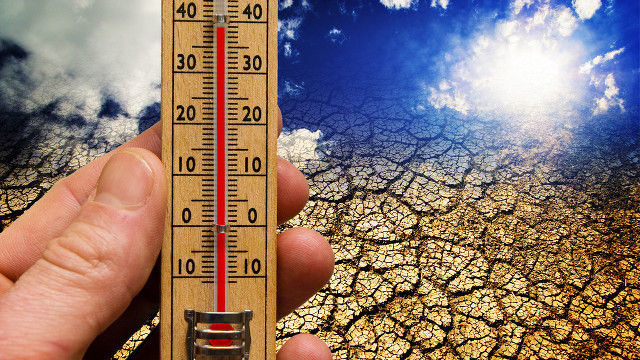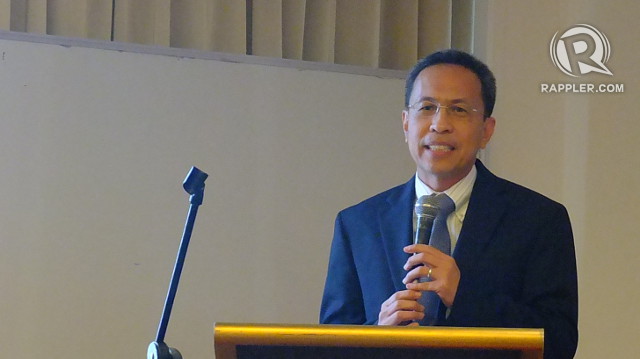SUMMARY
This is AI generated summarization, which may have errors. For context, always refer to the full article.

MANILA, Philippines – More hot and dry days are ahead for the Philippines while the number of storms to hit the country every year will greatly vary.
These are some of the initial findings presented by leading Filipino scientists, taken from the “Philippine Climate Change Assessment Report”– the first report on how climate change will affect the Philippines. (READ: After Yolanda/Haiyan: The worst is yet to come)
The initial findings of the report were presented on Wednesday, July 9, as part of an outreach event of the Intergovernmental Panel on Climate Change (IPCC). The IPCC is a Nobel Prize-winning group of hundreds of scientists from all over the world collating and assessing findings on climate change.
The IPCC’s most recent report, the Fifth Assessment Report (AR5), concluded that global warming is unequivocal and likely driven by human activities. It also determined that global temperatures should not go over 2 degrees Celsius if humanity wants to avoid catastrophic extreme weather events, deadly droughts and destructive sea level rise. (READ: 6 ways climate change will affect PH cities)
The Philippine report was prepared by Filipino IPCC authors, widely recognized as the leading scientists in their field of study. This is the first such report on the Philippines and the first report on country-specific climate change impacts in Southeast Asia.
The IPCC scientists had met informally and decided to make the report, which itself does not do any new research but instead collects local and international published scientific work, assesses them and integrates them into one comprehensive report. This is similar to the IPCC reports on the global impact of climate change.
“We tried to follow the IPCC approach as much as possible,” Dr Rodel Lasco, the report’s lead scientist and scientific director of the Oscar M. Lopez Center (OML), told Rappler.
Like the IPCC AR5, the Philippine report is composed of 3 sub-reports produced by 3 working groups of scientists. The reports each tackle aspects of the climate change phenomenon: the Physical Science Basis; Impacts, Adaptation and Vulnerability; and Mitigation.
Mitigation is lowering the emission of greenhouse gases (GHG) which keep the sun’s heat stuck in the Earth’s atmosphere, causing the planet to warm up.
Authors of the report include scientists from the Philippine Atmospheric, Geophysical and Astronomical Services Administration (PAGASA), Ateneo de Manila University (ADMU), University of the Philippines, OML Center and the Manila Observatory.
These scientists contribute their expertise in fields like atmospheric physics, climatology, meteorology, marine and coastal geology, and environmental science.
Like in the IPCC, the scientists will not receive compensation for their work although the report is receiving funding from the Climate Change Commission and OML Center.
The Coordinating Lead Authors of the 3 working groups are ADMU president Fr Jose Villarin; UP Los Baños chancellor Rex Victor Cruz; and Leandro Buendia, coordinator of the UNFCCC Southeast Asia Greenhouse Inventory Capacity Building Project.
Here are the initial findings of the Philippine Climate Change Assessment Report:
Physical Science Basis
- The global mean temperature warming of 0.85 degrees Celsius cannot be explained by warming due to natural causes. It is extremely likely that this is due to human activities which lead to high emission of greenhouse gases (GHG).
- The annual mean temperature of the Philippines is 26.6 degrees Celsius with a high variability in rainfall. This means there can be heavy rainfall in one year’s rainy season, then a very dry rainy season in the next year.
- Our tropical and maritime climate is influenced by large-scale systems like the northeast (Amihan) and southwest (Habagat) monsoons, tropical cyclones, El Niño South Oscillation (ENSO). It is also affected by local-scale phenomena like sea and lake breezes, and urban heat islands.
- From 1951 to 2010, the Philippines’ annual mean temperature increased by 0.65 degrees Celsius with a mean rate of 0.01 degree Celsius per year.
- During this period, there were more hot days and warm nights observed and less cold days and nights.
- Records from 1951 to 2008 show increasing intensity and frequency of rainfall in most parts of the country.
- There seems to be a decreasing trend in the frequency of tropical cyclones but a higher inter-annual variability. This means that there are years when there can be as many as 33 storms, usually years that follow a La Niña event; and there are years when there are as little as 11 tropical cyclones, usually years after intense El Niño.
- Sea levels have been rising and may pose a hazard particularly to coastal ecosystems and settlements.
- Aerosol concentrations, land use change and urbanization can also affect the climate and ecosystems at a regional scale and may contribute to the greenhouse effect.
- Based on climate projections, the Philippines’ annual mean temperature will increase by 0.9 to 1.1 degrees Celsius in the 2020s, and 1.8-2.2 degrees Celsius in the 2050s.
- Hot days and dry days are likely to be more frequent over the Philippines with more heavy rainfall days in Luzon and Visayas.
Impacts, Adaptation and Vulnerability
- Human activities are the main drivers of changes in ecosystems.
- Impacts of hazards like typhoons on coastal systems affect vulnerability.
- A changing climate has negative impacts on crop productivity and fisheries. Studies focused on rice, corn, and fisheries reveal considerable consequences on food security.
- The impact of climate change on health and the appropriate adaptation measures are the least explored. But studies have shown the link between climate change and likelihood of water- and heat-related sickness and vector diseases.
- Adaptation practices are accumulating particularly in coastal systems and agriculture, forestry, and fisheries.
- Governments in various levels are starting to integrate climate change considerations into their development plans.
- The type and species of forest biomes and species may shift as a result of climate change.
Mitigation of Climate Change
- The Philippines contributes very little to global GHG emissions. Of total global emissions in 2010, the country is estimated to have only contributed 0.31%.
- In 1994, the energy and agriculture sector were the two biggest contributors to global GHG emissions. The energy sector contributed 40.6% while agriculture contributed 32.9%.
- By 2010, agriculture’s contribution shot up by 12%. This contribution includes methane and nitrous oxide emissions from livestock, methane emissions from rice cultivation, and nitrous oxide emissions from organic and inorganic nitrogen fertilizer.
- Coal, at 39%, is the country’s biggest source of power followed by renewable energy at 28%. Natural gas is the third major power source (27%) followed by oil (6%).
- If the Philippine power sector continues to depend on coal, emissions are likely to increase by around 400% in year 2030, compared to 2007 levels.
- The garbage generated by the country is the third biggest contributor of GHG emissions. Of its contribution, methane from landfills constitutes the biggest chunk followed by nitrous oxide from waste water.
- The National Capital Region (NCR), Central Luzon, and Northern Tagalog are the 3 largest generators of waste in the country.
- Philippine forests are significant carbon sinks. They can store most of the country’s carbon emissions, a process which would prevent their release into the atmosphere.
Lasco stressed that the report is far from final. In fact, they have yet to finish the first draft he hopes will be finalized by September. If all goes as planned, the report will be launched during Climate Change Consciousness Week in November.
Because of its work-in-progress nature, Lasco welcomes more contributions from both foreign and Filipino scientists who have published research. The report’s initial findings are posted on the OML Center website to enable other scientists to comment.
“We need a lot of help to finish this. It’s not going to be easy but it’s also very exciting,” Lasco told Rappler.
The biggest difficulty the team faces is the availability and lack of time of the contributing scientists, most of whom work in the academe or other research organizations. – Rappler.com
Climate change image via Shutterstock
Add a comment
How does this make you feel?

There are no comments yet. Add your comment to start the conversation.